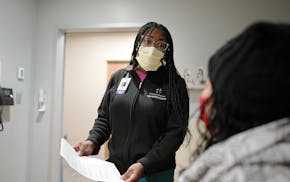workforce development
CliftonLarsonAllen to hire 100 downtown
Accounting firm CliftonLarsonAllen (CLA) plans to hire up to 50 college interns, including minority students, to meet staffing needs in downtown Minneapolis and CLA's commitment to the Hennepin Workforce government-business coalition of employers committed to more diverse workplaces.
Bryon Reinhart, managing principal of the 800-employee CLA Minneapolis office, said: "The internship program gives students in our downtown community a start in accounting and an opportunity to develop long-term careers. And it gives [CLA] access to talented job seekers, who will in turn help us serve our clients across the country."
The students, including from two-year colleges, will work for CLA supervisors and veterans in an "outsourced shared-services center" to which CLA is adding 100 people, including interns. It provides privately held companies with certain accounting, financial-transaction and other bookkeeping services.
The purpose is to meet a business need, with an eye on creating opportunity for young people and further diversifying the profession, he said. Also, there is concern from economists that the Twin Cities economy will falter without more trained workers.
The participating colleges are: Augsburg University, Minneapolis Community & Technical College (MCTC), the two-year Dougherty Family College at the University of St. Thomas, St. Catherine University and Metropolitan State University.
"The downtown business community is committed to supporting the development of young students from our community who aspire to learn and be prepared to transition into the next phase of their careers," said CEO Steve Cramer of the Downtown Council and co-chair of the Hennepin Workforce initiative. "This employer is committed to our workforce of the future and the goals of the Hennepin County Workforce Leadership Council."
Several dozen public and private employers, from Hennepin County to Wells Fargo and Fairview Health, have worked on "career pathways" initiatives through local colleges, nonprofit job trainers and others focused on $15-an-hour starting jobs.
Hennepin County, which employs 13,000 workers, and private employers have signed on partly because they need to fill behind baby boomer retirees.
A third of Hennepin County's workforce will be eligible to retire by 2025. The growth in the Twin Cities workforce will come almost entirely from minority members, according to demographic forecasts. The private sector faces the same demographics and opportunity.
Forecasts suggest there will be 100,000 more Twin Cities-area jobs than qualified applicants by 2020. There already are shortages in IT, transportation, health care and public safety. Since 2010, minority hiring in the construction trades and technology has grown much faster than white hiring in the Twin Cities area, according to state labor statistics.
Immigrants also are considered vital to economic growth.
Students who complete certain requirements are guaranteed paid internships that lead to $15-an-hour jobs and benefits.
Neal St. Anthony
energy conservation
State looks to emulate business on energy use
Matt Massman, Minnesota administration commissioner, oversees a far-flung network of buildings, vehicles and equipment used by 30,000 employees.
He said the State Capitol complex in St. Paul has cut energy use by 24 percent over a decade thanks largely to new windows and more-efficient HVAC systems.
"We save about $2 million a year," Massman said last week. "We also have 226 hybrids and 16 electric vehicles in our fleet of 2,000. State agencies have been reflecting the value of energy and environment. We do need to get more focused."
He and Lt. Gov. Tina Smith, who came from the business world, want to emulate some of the big companies such as Cargill and General Mills that have pledged to double down on energy savings and decreased carbon output over the past decade from their far-flung empires.
They were behind Gov. Mark Dayton's recent order to reduce fuel consumption by 30 percent over the next decade; cut greenhouse gas emissions by 30 percent and slash water use by 25 percent. Dayton ordered state managers to boost recycling and composting to a combined 75 percent.
"This comes out of my business background and our responsibility to run this enterprise well," said Smith, who consulted with several companies on successful carbon-reduction programs. "An ethical and economic responsibility. Cargill and Best Buy have that … same way of thinking."
Recent studies indicate that Minnesota conservation and alternative energy industries are producing jobs at double or more the rate of the overall economy.
The state lacks fossil fuels, and wind and solar industries are among its fastest growing.
Massman has secured a $200,000 grant from the McKnight Foundation to set up a digital "dashboard" that will monitor six "strategic sustainability categories" by the office of enterprise sustainability, established last year.
"This is about being systematic," said Minnesota Pollution Control Agency Commissioner John Linc Stine.
"Instead of one department working on composting, while another looks at sustainable purchasing, we're all following the same map."
Neal St. Anthony

St. Anthony: 'Patient' investing paying off for St. Paul's Hill Capital

Jennifer Smith, leader of Burnsville's Innovative Office Solutions, has died

St. Anthony: Medical professions in Minnesota need more people of color in their ranks



